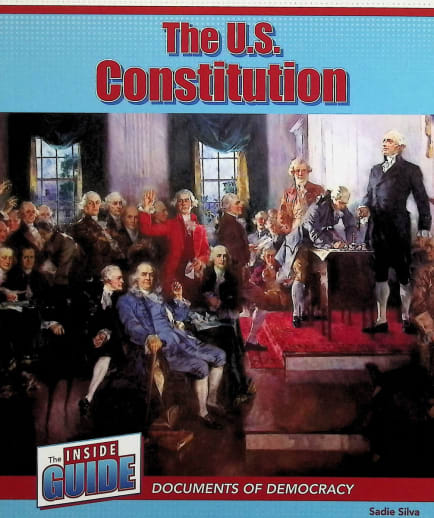Change and compromise is a tenant of the United States. The evolution of the Articles of Confederation to this nation’s Constitution highlights the importance of governance and thought of the collective whole. The brief text introduces young readers to the systems established by the Constitution and the checks and balances set in place for running this nation. Vocabulary words are indicated throughout and can easily be found in the glossary. Discussion questions allow students critical thinking opportunities. Pgs. 32, sc. ~Rebecca
U.S. Constitution (Inside Guide: Documents of Democracy)
SKU
045573
ISBN
9781502660381
Grade 4-6
These icons are designed to help you quickly understand and learn important information about our products.
Teaching Method
Traditional
Teacher-centered curriculum commonly used in classrooms that may include a text, teacher manual, tests, etc.
Charlotte Mason
A methodology based on the work of a 19th century educator who maintained that children learn best from literature (Living Books), not textbooks.
Classical
A methodology based on the Latin Trivium (three stages of learning), including the grammar stage (memorization and facts), logic stage (critical thinking), and rhetoric stage (developing/defending ideas).
Unit Study
A thematic or topical approach centered around one topic that integrates multiple subject areas.
Montessori (Discovery)
A methodology based on the work of a 20th century educator that emphasizes student and sensory-driven discovery learning and real-life applications.
Other
Other methodologies
Religious Content
Secular
Contains content contrary to common Christian beliefs (i.e. evolution).
Neutral
Avoids religious or theoretical topics or presents multiple viewpoints without preference.
Christian/Religious
Faith-based or including instructional religious content.
Learning Modality
Auditory
Learns through listening, talking out loud or reading out loud.
Visual
Learns through seeing, prefers written instructions and visual materials.
Kinesthetic/Tactile (Hands-On)
Learns through moving, doing and touching.
Multi-Sensory
Curriculum that employ a variety of activities/components.
Presentation
Sequential
Curriculum progresses through well-defined learning objectives. Emphasizes mastery before moving to the next topic.
Spiral
Topics and concepts are repeated from level to level, adding more depth at each pass and connecting with review.
Conceptual/Topical
Focus is on the “why,” often with a unifying concept as well as specific skills; coverage may be broader.
Teacher Involvement
Low Teacher Involvement
Student-led materials; parent acts as a facilitator.
Medium Teacher Involvement
A mix of teacher-led time and independent student work.
High Teacher Involvement
Teacher-led lessons; may utilize discussions, hands-on activities and working together.
Additional Materials Required
No other materials needed
Everything you need is included.
Other Materials Required
There are additional required resources that are a separate purchase.
Other Materials Optional
There are additional resources mentioned or recommended but are not absolutely necessary.
Consumable
Consumable
Designed to be written in; not reusable.
Non-Consumable
Not designed to be written in; reusable.
Our Price
$11.58 $11.58 $8.75
Rainbow Savings: $2.83
Product Overview
- Learn how a document written in 1787 is still shaping this country today!
- These quick reads include Fast Facts about historical documents for elementary students
- Wonderful pictures and maps help students visualize history
Description
Publisher's Description of U.S. Constitution (Inside Guide: Documents of Democracy)
The Constitution is arguably the most important document in the United
States today. It forms the basis of all laws that are passed in the
country, and the Supreme Court's interpretation of the document has
influenced countless court decisions and new policies. For these
reasons, it's crucial for all American citizens to have at least a basic
knowledge of what the Constitution contains. Readers are given an
overview of this important document, helping them think critically about
proposed laws in the 21st century. Exciting fact boxes, sidebars, and
photographs add to this essential reading experience.
Category Description for Inside Guide: Documents of Democracy
Introduce young readers to the documents that laid the bedrock for this nation. Some documents may surprise you, as you will learn about the Mayflower Compact and the Magna Carta. These brief readers introduce great vocabulary, timelines, classical artwork, and critical thinking discussion questions, and would make a great unit study (especially during an election year). There are factoids on people, places, and events throughout the pages that are easy to engage with and will stick in little minds. Nonfiction readers like these open students to further research and can lead students to interest-based learning during your school year. ~Rebecca
Details
| Product Format: | Paperback |
|---|---|
| Grades: | 4-6 |
| Brand: | Cavendish Square |
| ISBN: | 9781502660381 |
| Length in Inches: | 8.4375 |
| Width in Inches: | 6.9375 |
| Height in Inches: | 0.0625 |
| Weight in Pounds: | 0.2 |
Videos
Reviews

